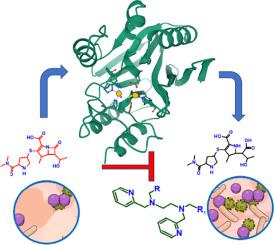Journal of Inorganic Biochemistry ( IF 3.9 ) Pub Date : 2020-11-21 , DOI: 10.1016/j.jinorgbio.2020.111315 Luana La Piana 1 , Valentina Viaggi 2 , Luigi Principe 3 , Stefano Di Bella 4 , Francesco Luzzaro 2 , Maurizio Viale 5 , Nadia Bertola 5 , Graziella Vecchio 6

|
Bacteria have developed multiple resistance mechanisms against the most used antibiotics. In particular, zinc-dependent metallo-β-lactamase producing bacteria are a growing threat, and therapeutic options are limited. Zinc chelators have recently been investigated as metallo-β-lactamase inhibitors, as they are often able to restore carbapenem susceptibility. We synthesized polypyridyl ligands, N,N′-bis(2-pyridylmethyl)-ethylenediamine, N,N,N′-tris(2-pyridylmethyl)-ethylenediamine, N,N′-bis(2-pyridylmethyl)-ethylenediamine-N-acetic acid (N,N,N′-tris(2-pyridylmethyl)-ethylenediamine-N′-acetic acid, which can form zinc(II) complexes. We tested their ability to restore the antibiotic activity of meropenem against three clinical strains isolated from blood and metallo-β-lactamase producers (Klebsiella pneumoniae, Enterobacter cloacae, and Stenotrophomonas maltophilia). We functionalized N,N,N′-tris(2-pyridylmethyl)-ethylenediamine with D-alanyl-D-alanyl-D-alanine methyl ester with the aim to increase bacterial uptake. We observed synergistic activity of four polypyridyl ligands with meropenem against all tested isolates, while the combination N,N′-bis(2-pyridylmethyl)-ethylenediamine and meropenem was synergistic only against New Delhi and Verona integron-encoded metallo-β-lactamase-producing bacteria. All synergistic interactions restored the antimicrobial activity of meropenem, providing a significant decrease of minimal inhibitory concentration value (by 8- to 128-fold). We also studied toxicity of the ligands in two normal peripheral blood lymphocytes.
中文翻译:

多吡啶配体作为潜在的金属-β-内酰胺酶抑制剂
细菌已经对最常用的抗生素产生了多种耐药机制。特别是,锌依赖性金属-β-内酰胺酶产生细菌的威胁越来越大,治疗选择有限。最近研究了锌螯合剂作为金属-β-内酰胺酶抑制剂,因为它们通常能够恢复碳青霉烯的敏感性。我们合成了多吡啶基配体,N , N '-双(2-吡啶基甲基)-乙二胺,N,N,N'-三(2-吡啶基甲基)-乙二胺,N , N'-双(2-吡啶基甲基)-乙二胺-N-乙酸(N,N,N'-三(2-吡啶基甲基)-乙二胺-N'-乙酸,可以形成锌(II)配合物。我们测试了它们恢复美罗培南对从血液和金属β-内酰胺酶生产者(肺炎克雷伯菌、阴沟肠杆菌和嗜麦芽窄食单胞菌)中分离的三种临床菌株的抗生素活性的能力。我们功能化了 N,N,N'-tris(2-pyridylmethyl)-乙二胺与 D-丙氨酰-D-丙氨酰-D-丙氨酸甲酯,目的是增加细菌摄取。我们观察到四种多吡啶配体与美罗培南对所有测试分离株的协同活性,而组合N , N'-双(2-吡啶基甲基)-乙二胺和美罗培南仅对新德里和维罗纳整合子编码的产金属β-内酰胺酶细菌具有协同作用。所有协同作用都恢复了美罗培南的抗菌活性,显着降低了最小抑菌浓度值(降低了 8 到 128 倍)。我们还研究了两种正常外周血淋巴细胞中配体的毒性。

























 京公网安备 11010802027423号
京公网安备 11010802027423号